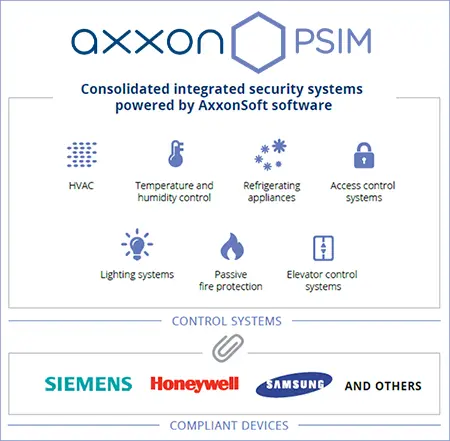BACnet integration module
BACnet is a multipurpose protocol supported by various equipment including ACS/FAS systems as well as industrial automation systems, smart buildings control systems, lighting systems, life support, power supply systems, elevators control systems and other building management systems. There is no need to use any other software wrapper while using BACnet Wrapper module — whereas for OPC Wrapper OPC Server is needed.
Each device has the number of channels and parameters that can be available both for reading only and for reading-recording. BACnet Wrapper integration module allows you to get parameter values and change them. BACnet device is monitored and controlled by getting and changing parameter values.
The device manufacturer provides the document that says what parameters the device has, what values these parameters can have and what result can be obtained by changing the parameter values. The required parameters are chosen when configuring the integration module and corresponding objects are created and configured in Axxon PSIM. The values of variable parameters can be set using objects on the map or using macros and scripts. Parameter display can also be configured on the map.
Automated building control systems
BACnet Wrapper integration module can be used to connect PSIM to automated building control systems.
Such systems perform the following:
- HVAC integrated control as well as water supply and drain system management, power supply and lighting control.
- Integration with various devices as well as Internet and Intranet data sources enabling intelligent control over key information collected from the site.
Connection of such system to Axxon PSIM using the BACnet protocol enables displaying the power status (on/off), general system failures and fire alarms on the map or in the event logs, i.e. one can monitor the system the same way as in other ACFA-PSIM integrations without installing these systems.

HVAC systems
BACnet integration module allows connecting PSIM to various HVAC (heating, ventilating and air conditioning) systems, monitoring their state and controlling components of these systems.
Temperature and humidity control
Temperature control is required in shop premises. Connection of HVAC equipment to PSIM using the BACnet protocol allows getting data (temperature, humidity) from sensors connected to the controller in a real time mode, as well as managing the connected equipment in order to control temperature.
Passive fire protection
Passive fire protection equipment used in HVAC systems is represented by fire dampers that prevent the spread of fire inside the ductwork through fire-resistance rated walls and floors.
BACnet integration module allows reading and controlling current position of such dampers (actuators) connected to PSIM using the BACnet protocol, i.e. the operator can control the spread of fire on the map — opening and closing the dampers.
The manufacturer embeds micro code into the device — this micro code automatically controls the device (close and open a fire damper according to its own internal logic). BACnet integration module allows managing such micro code. Operator commands are considered to be with higher priority than micro code commands, i.e. if the operator sees that micro code is not efficient, he can control the system manually - for example, direct the fire to the required area (with no people in it).
Lighting systems
BACnet is also used for the control of lighting systems. Micro code embedded in BACnet devices enable automatic control over light sources (turn them on/off) in order to provide sufficient light and save electric power depending on the natural daylight and the presence of people on the premises. Such system is perfect for office buildings, conference rooms, classrooms, sports and other halls as well as for industrial premises.
When connecting the notification system to PSIM using the BACnet protocol the operator can control the state of light sources on the map and manage them if necessary. When using such control system along with light sensors it is possible to move automation logic to PSIM side: manage light sources using macros and scripts.
Elevator control systems
Elevator control systems are the part of automated building control systems that help to improve the performance of such systems. These systems enable programmable automatic elevator operation.
When connecting the elevator control system to PSIM using the BACnet protocol the operator can control the location and state of elevators on the map and manage them if necessary (moving them from one floor to another, opening and closing the doors, etc.).
Access control systems
BACnet integration module allows connecting ACS systems to PSIM without any other integration. Connection of ACS using BACnet protocol enables monitoring and control of such system. In particular, if the protocol implementation provides such features, then PSIM can be configured allowing the operator to open and close the door using the card, i.e. perform the same actions as in standard ACS integration.
Refrigerating appliances
BACnet is used in refrigerating engineering — that is why BACnet integration module can be used to monitor and control such appliances. In particular, the use of this integration module allows not only reading and displaying current temperatures in PSIM™ interfaces, but also auto notifying the operator about refrigerating equipment failures, non-closed doors and many other cases. Using standard features of Axxon PSIM one can configure SMS/ e-mail/voice notification.
Industrial automation systems
BACnet integration module is used in industrial automation systems (especially at the field scale of these systems) — various sensors including temperature, humidity, emergency, oil pressure, fan control and many other sensors. Connection of various types of sensors using the BACnet protocol allows operator to monitor sensor readings on the map and in the event log. This will also allow one to automatically perform various actions in the system depending on such readings using standard features of PSIM — macros and scripts.